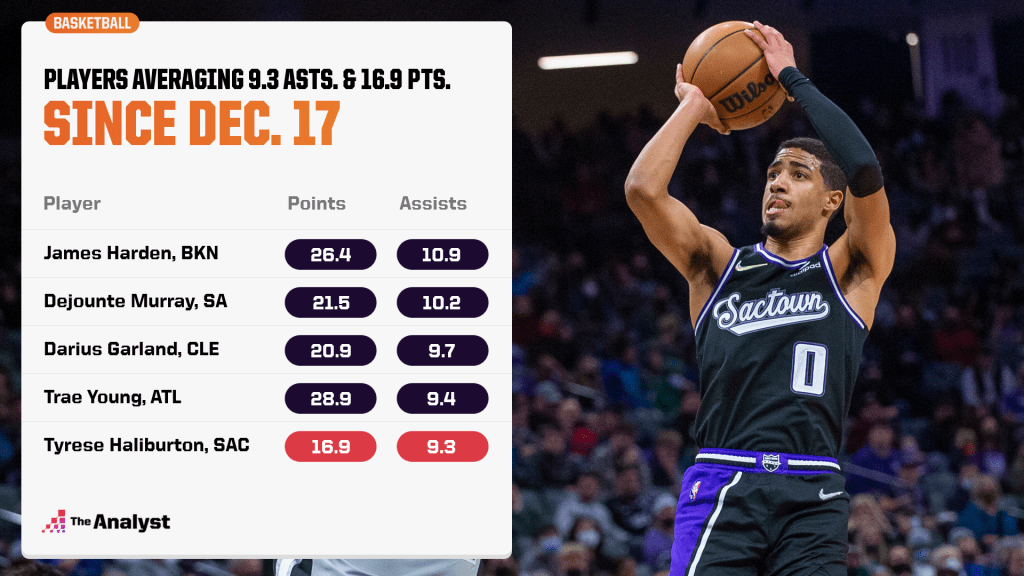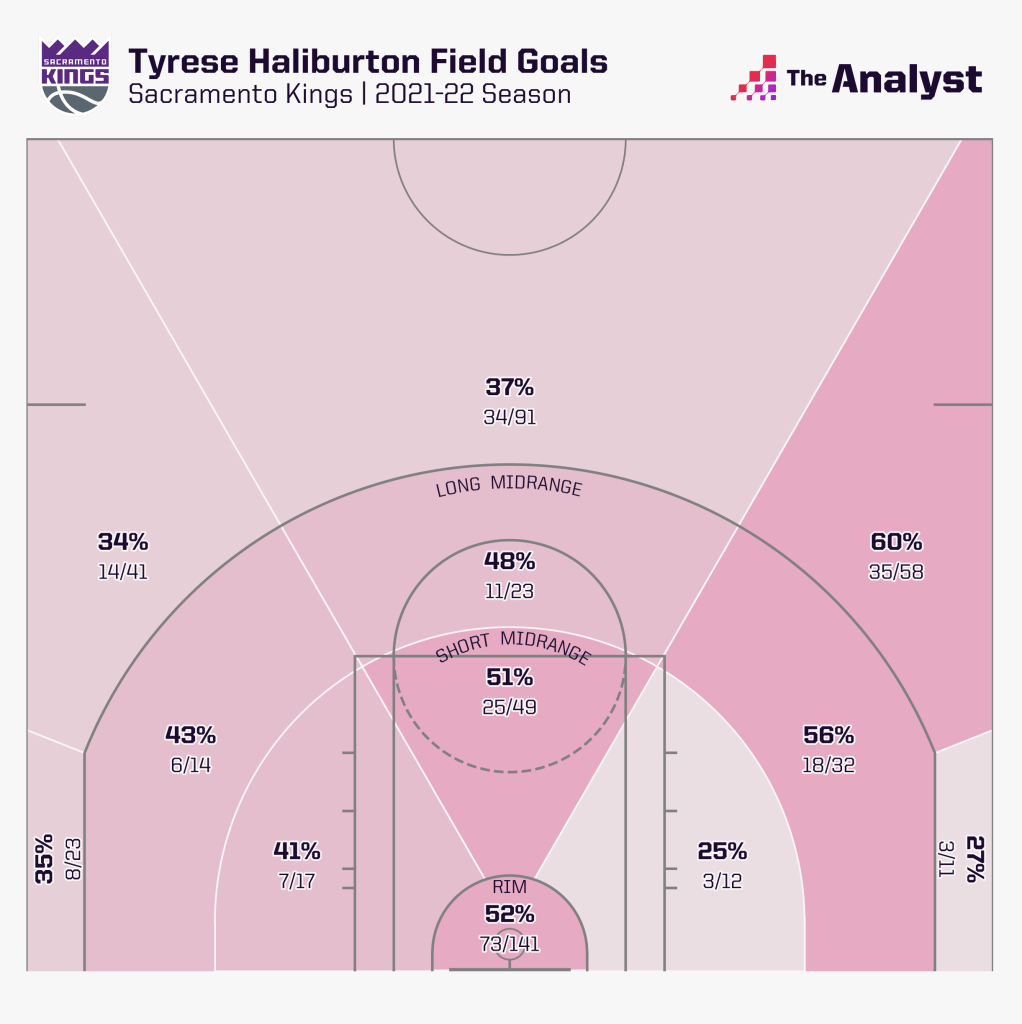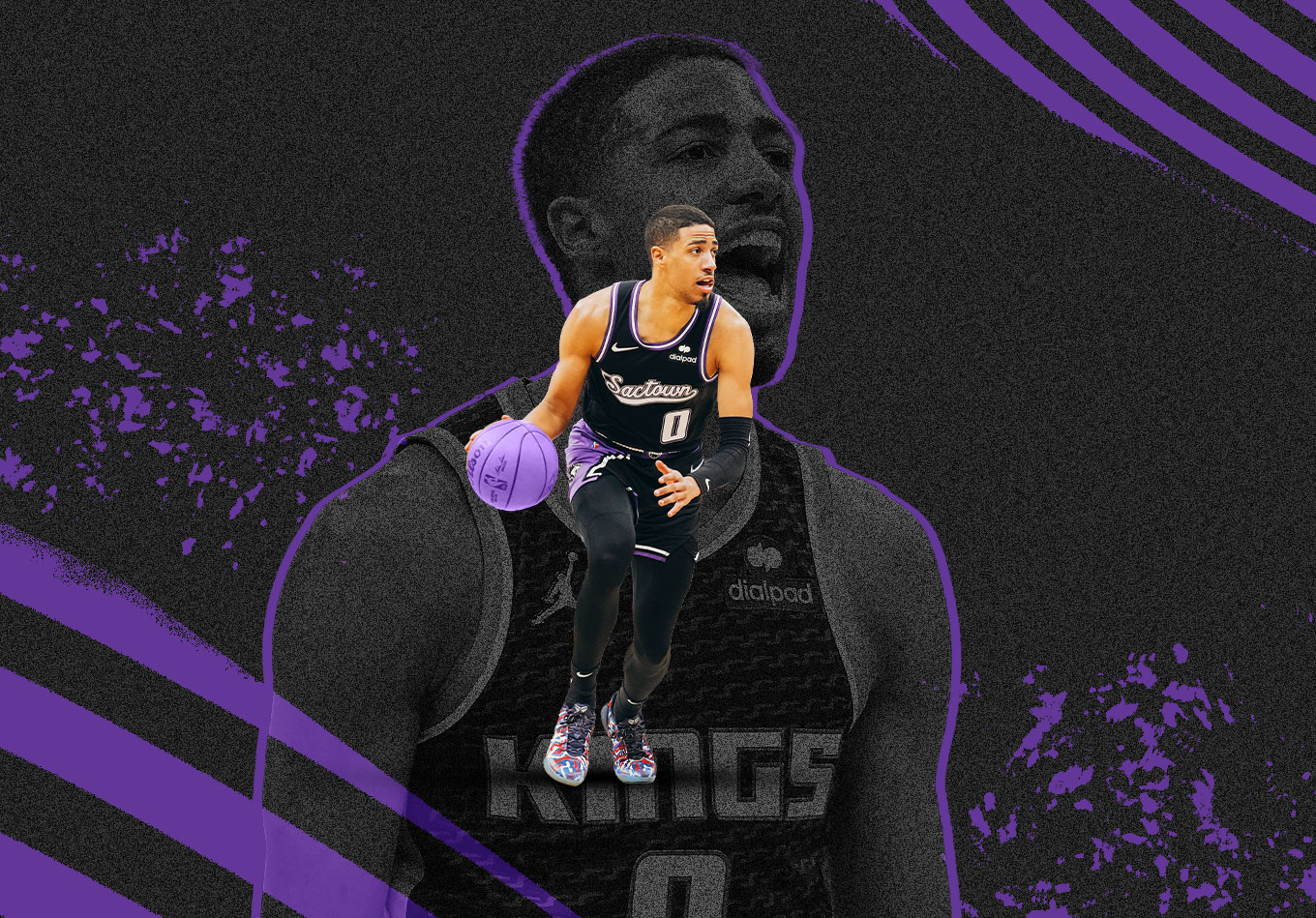Tyrese Haliburton’s basketball rise is marked by a constant defiance of expectations.
Before thriving in a sizable role for a top-25 squad, he arrived at Iowa State as a freshman who wasn’t featured among ESPN’s top-100 recruits. After an exodus of talent, he slid into a prominent ball-handling gig and emerged as one of the nation’s premier players, only for his season to be derailed by injury.
Despite the substantial strides between those first two years in college, Haliburton fell to 12th in the 2020 NBA Draft and had quite a few people skeptical of his ceiling, including yours truly (whoops). Then, he enjoyed another developmental jump to finish third in the NBA’s Rookie of the Year voting behind two dudes who look like surefire future All-Stars.
By no means was the consensus rushing to cap the possibilities for his encore season and beyond. Yet he’s once again surpassed preconceived notions of his present-day abilities, especially as of late. Over his past 19 games, he’s averaging 16.9 points, 9.3 assists (2.7 turnovers) and 1.4 steals on .487/.448/.843 shooting splits.
Haliburton is one of only two players (along with Dejounte Murray of the San Antonio Spurs) to average at least 16.9 points, 9.0 assists and 1.4 steals since Dec. 17. On the season, he leads the Kings in DRIP, which projects a player’s contribution to a team’s plus/minus per 100 possession, at plus-0.9 and DELTA, the difference in DRIP from the beginning of the season, at plus-1.0.

Much of his improvement has coincided with Sacramento Kings head coach Alvin Gentry prioritizing him as an on-ball creator to degrees former head coach Luke Walton did not. Haliburton didn’t necessarily struggle under the previous regime, but his breakout of the last six weeks showcases that the old usage was overly rigid for his full complement of skills.
Since Gentry took over, De’Aaron Fox has largely shifted from primary initiator to primary scorer, while Haliburton has gone from secondary initiator to primary initiator, which has been beneficial for everyone involved.
With Walton at the helm this year, Fox averaged 81.8 touches (86.5 in 2020-21) and Haliburton averaged 64.1 (57.6 in 2020-21), according to NBA.com. With Gentry in charge, Fox was averaging 76.5 touches, compared to Haliburton’s 78.3 heading into Wednesday night’s loss at Atlanta. The dynamic guards have also seen similar stats like time of possession and dribbles per touch trend in opposite directions under Gentry.
Last season, Fox averaged 25.2 points and 7.2 assists, while Haliburton averaged 13.0 points and 5.3 assists. Since Gentry took over, Fox is averaging 21.9 points and 4.7 assists; Haliburton is averaging 14.2 points and 8.3 assists.
Whereas a bunch of the old numbers indicated a clear divide in the offensive hierarchy, new numbers indicate an equal partnership in which one is relied upon to score more and the other leans into table-setting.
Enabling these alterations is Haliburton’s sustained blossoming as a shot creator. When paired with his long-standing ancillary skills of passing, spot-up shooting (41.3% from 3-point range in his career) and defensive playmaking, he’s fitting the mold of an incredibly tantalizing franchise cornerstone for the Kings. At a minimum, he and Fox should be viewed on the same ground moving forward, which was probably not the case within most crowds entering the season.
As a rookie, the pull-up triple was assuredly in Haliburton’s arsenal. He shot 37.5% (48 of 128), which composed 20.7% of his offense.
This year, he’s expanded upon that to become even more devastating. He’s shooting 42.6% (52 of 122), which composes nearly 25% of his offense. Among 96 players to take at least 50 pull-up 3s this season, Haliburton’s 42.6% clip ranked second heading into Wednesday.
What makes him so fascinating to watch and analyze is that his unorthodox release suggests he’d have trouble scaling up the volume of these shots. But he doesn’t. A year and a half running, he’s dotting step-backs in the face of defenders with regularity.
When teams duck under screens, he’ll immediately pop that sucker. Don’t let the atypical mechanics deceive, he’s diverse in his release point and speed, depending on what the defensive coverage warrants.
About 14.0% fewer of his field goals are derived via assists this year (51.4% vs. 37.5%), including just 58.1% of his long balls (90th percentile).
Despite heightened self-creation duties, his true shooting percentage is 2.6 points above league average after being just 1.3 points above as a rookie (please, admire his shot chart).

Inside the arc, he’s also growing as a self-creator. He brilliantly primes and manipulates screens for space, often rejecting picks or utilizing push-ahead dribbles into open real estate. The way he covers ground and creates advantages with his handle appears more fluid than previous years, which empowers him as a downhill scorer. Playing through contact is less of a burden as well.
Quickly processing and dissecting plays on the fly, he’s a genius problem-solver – one of the many reasons he outpaces expectations at every step. Few players adapt/expand their games and read the floor like him. He’s en route to a special career.
If Option A isn’t available, he promptly transitions to his bevy of counters. Elongated strides and gather steps, and a masterful understanding of angles are central to his multifaceted interior scoring.
How he occupies and interacts with space seems genuinely unique. Just look at all the different angles he releases shots from, how he arrives at his destinations and how he generates space to fire. It’s mesmerizing.
In recent weeks, Sacramento has been linked to both Ben Simmons and Domantas Sabonis. Conflicting reports as to whether Fox or Haliburton are available in those talks have arisen.
Haliburton hasn’t (yet?) ascended to untouchable status in discussions for any star. But for those caliber of stars, he should be (and perhaps already is). His trajectory dating back to high school is staggeringly impressive. He’s going to be supremely good. Even if he doesn’t become a bonafide primary initiator, he can comfortably toggle across roles, thanks to skills he’s harnessed for years.
As a freshman at Iowa State, he could bury spot-up 3s, dish out connective passes and occasionally attack closeouts. Shooting off the dribble, spamming ball-screen actions and shrugging off defensive physicality didn’t really seem viable.
Three years later, he efficiently hoists pull-up jumpers, runs a plethora of pick-and-rolls, and scores through contact as a lead creator on an NBA team. He’s a basketball savant who rapidly evolves his game and views the sports through a lens nobody else owns.
Whatever he accomplishes next to shatter expectations and inch closer toward stardom will be an absolute joy.
Enjoy this? Subscribe to our mailing list to receive exclusive weekly content.
Research support provided by Chase Weight. Design by Matt Sisneros.
